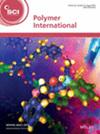求助PDF
{"title":"高油基大豆油阴离子聚氨酯分散体的交联效应","authors":"Jasna Djonlagić, Zoran Petrović, Jian Hong, Milica Lovrić Vuković","doi":"10.1002/pi.6752","DOIUrl":null,"url":null,"abstract":"<p>Waterborne polyurethane dispersions are known as non-toxic, non-flammable, environmentally friendly products widely used in the coatings industry. We prepared a series of anionic dispersions based on the polyol from high-oleic soybean oil, isophorone diisocyanate and dimethylol propionic acid. Stable anionic dispersions were achieved when the acid content in formulations ranged from 7.7 to 10.8 wt%. All dispersions in this series had average particle sizes of 163–211 nm with unimodal size distribution. Utilization of the high-oleic oil, with three double bonds on average, and the resulting trifunctional polyol, renders crosslinked products with improved hydrophobicity and excellent chemical and physical properties. Also, it is beneficial in the control of the synthesis process since it reduces the chance of gelation during the dispersion preparation, compared to natural oils with higher unsaturation. The network formation in the systems used was analyzed by applying gelation theory to adjust optimal time for the dispersion in water. It was found that the isocyanate reaction with water always produces imperfect networks but the degree of imperfection can be controlled by the reaction time before dispersion in water. The polyurethane formulations with hard segment content of 39–46 wt% resulted in cured elastomeric films, with single glass transitions around room temperature and low phase separation, but good mechanical properties. The films exhibited enhanced hydrophobicity, low water absorption and water contact angle close to 90°, with promising applications in leather, wood, paper and plastic coatings. © 2025 Society of Chemical Industry.</p>","PeriodicalId":20404,"journal":{"name":"Polymer International","volume":"74 7","pages":"593-601"},"PeriodicalIF":3.6000,"publicationDate":"2025-02-13","publicationTypes":"Journal Article","fieldsOfStudy":null,"isOpenAccess":false,"openAccessPdf":"","citationCount":"0","resultStr":"{\"title\":\"Crosslinking effects on high-oleic soybean oil-based anionic polyurethane dispersions\",\"authors\":\"Jasna Djonlagić, Zoran Petrović, Jian Hong, Milica Lovrić Vuković\",\"doi\":\"10.1002/pi.6752\",\"DOIUrl\":null,\"url\":null,\"abstract\":\"<p>Waterborne polyurethane dispersions are known as non-toxic, non-flammable, environmentally friendly products widely used in the coatings industry. We prepared a series of anionic dispersions based on the polyol from high-oleic soybean oil, isophorone diisocyanate and dimethylol propionic acid. Stable anionic dispersions were achieved when the acid content in formulations ranged from 7.7 to 10.8 wt%. All dispersions in this series had average particle sizes of 163–211 nm with unimodal size distribution. Utilization of the high-oleic oil, with three double bonds on average, and the resulting trifunctional polyol, renders crosslinked products with improved hydrophobicity and excellent chemical and physical properties. Also, it is beneficial in the control of the synthesis process since it reduces the chance of gelation during the dispersion preparation, compared to natural oils with higher unsaturation. The network formation in the systems used was analyzed by applying gelation theory to adjust optimal time for the dispersion in water. It was found that the isocyanate reaction with water always produces imperfect networks but the degree of imperfection can be controlled by the reaction time before dispersion in water. The polyurethane formulations with hard segment content of 39–46 wt% resulted in cured elastomeric films, with single glass transitions around room temperature and low phase separation, but good mechanical properties. The films exhibited enhanced hydrophobicity, low water absorption and water contact angle close to 90°, with promising applications in leather, wood, paper and plastic coatings. © 2025 Society of Chemical Industry.</p>\",\"PeriodicalId\":20404,\"journal\":{\"name\":\"Polymer International\",\"volume\":\"74 7\",\"pages\":\"593-601\"},\"PeriodicalIF\":3.6000,\"publicationDate\":\"2025-02-13\",\"publicationTypes\":\"Journal Article\",\"fieldsOfStudy\":null,\"isOpenAccess\":false,\"openAccessPdf\":\"\",\"citationCount\":\"0\",\"resultStr\":null,\"platform\":\"Semanticscholar\",\"paperid\":null,\"PeriodicalName\":\"Polymer International\",\"FirstCategoryId\":\"92\",\"ListUrlMain\":\"https://scijournals.onlinelibrary.wiley.com/doi/10.1002/pi.6752\",\"RegionNum\":4,\"RegionCategory\":\"化学\",\"ArticlePicture\":[],\"TitleCN\":null,\"AbstractTextCN\":null,\"PMCID\":null,\"EPubDate\":\"\",\"PubModel\":\"\",\"JCR\":\"Q2\",\"JCRName\":\"POLYMER SCIENCE\",\"Score\":null,\"Total\":0}","platform":"Semanticscholar","paperid":null,"PeriodicalName":"Polymer International","FirstCategoryId":"92","ListUrlMain":"https://scijournals.onlinelibrary.wiley.com/doi/10.1002/pi.6752","RegionNum":4,"RegionCategory":"化学","ArticlePicture":[],"TitleCN":null,"AbstractTextCN":null,"PMCID":null,"EPubDate":"","PubModel":"","JCR":"Q2","JCRName":"POLYMER SCIENCE","Score":null,"Total":0}
引用次数: 0
引用
批量引用



 求助内容:
求助内容: 应助结果提醒方式:
应助结果提醒方式:


